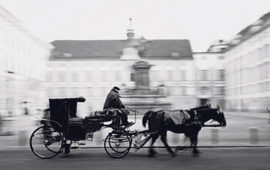> [Archived] Interviews

Romanians on Ringstrasse Cultural Guide Released in Vienna
At the beginning of November, the Vienna Romanian Cultural Institute has released the cultural guide Romanians on Ringstrasse, an absolute first in the Venetian book publishing field. Written by a Romanian and an Austrian, Gabriel Kohn and Peter Schubert, the guide is dedicated to the great Romanian personalities whose biographies have marked the multicultural history of the Austrian capital city.
Mr. Gabriel Kohn, assistant manager of the Vienna Romanian Cultural Institute and co-author of the guide, gave an interview on the birth of this project and the personalities of the musical field included in this bilingual publication.
The idea of this project was born, as usual, out of the identification of a necessity. On analysing the cultural image of Vienna and especially the Romanian cultural presence in the urban Venetian space, it is clear that this space is little populated from a cultural point of view, or underpopulated to be more precise. Therefore, the idea of a guide that leads through the centre of Vienna, along the main artery, along Ringstrausse, reveals the public Romanian cultural presences which were already mentioned in other works but so far have never been exposed to public opinion in a format both contemporary and pragmatic at the same time.
The Romanian presence in Vienna is characterized by a certain fascination exerted by the Austrian capital, a fascination both consumeristic and cultural. The guide retraces the Romanian footsteps in Vienna for the past 200 years and wishes to transform this fascination, somewhat existential, into a tighter relationship with the city. Practically, we only try to get the city even closer to the ones that have already been fascinated by it.
As to how long it took to elaborate this guide, the idea of taking up such work occurred to us last year and towards to end of 2010 it was already written. But elaborating such a guide does not only involve the editing of the guide, but also the design of its graphic concept, which is an utterly essential component of the pragmatic function of the guide. Therefore, around the end of 2010 the guide was ready, and in 2011 it became a visible presence. Towards the end of 2011 we even managed to implement the cultural guide, to introduce it into the Vienesse public circuit and to make it work as an instrument, as it was originally designed.
Which are the personalities of the musical field included in this guide and how did you describe their relation with Vienna?
The personalities of the Romanian musical world who either left their mark here or were significantly influenced by the Austrian capital are very numerous, of course. Most of the fifteen portraits included in the guide belong to the musical field, which is not at all surprising when we think about Vienna. There are various types of personalities: some had a solid career in Vienna and have become part of the Venetian cultural memory during the past 200 years and at a certain time they dominated the lyrical stage of the town. Among this type of personalities we could include Viorica Ursuleac, Ioan Holander, George Enescu or Eusebiu Mandiceski - if we were to consider voices both on the stage and behind it.
Then there are stories about personalities with a fulminating career in Vienna, but with a less fortunate ending. Maria Ciobotaru, for example, built an amazing career in Vienna, but also in Germany, she was adored as one of the biggest starts of the time, but her early death, before her fortieth anniversary, grieved the entire city. Traian Grozavescu's story doesn't have a happy ending either. After important achievements in Central Europe, at Cluj, Zagreb and Budapest, Grozavescu arrives in Vienna, at the Vienna Folk Opera and he also plays at Vienna State Opera, where he becomes a sort of prince of the Staatsoper, as the media of the time called him. At the peak of his career, right before going on tour in Germany and across the ocean, Traian Grozavescu is murdered by his own wife during a jealousy outburst, and the trial which followed the murder caught the attention of the entire country. Grozavescu's burial procession gathered almost half of Vienna's inhabitants along Ringstrasse the moment his body was led to the train station, as he would be buried in Lugoj.
Another story revolves around Ciprian Porumbescu, a destiny not very happy either, but extremely interesting, having Vienna as central spot. Here is where Ciprian Porumbescu studied and where the work Crai nou(New Moon)was composed. But this is also the place where the youngest of the Strauss brothers was willing to study one of Ciprian Porumbescu's waltzes and play it at one of the balls organized by Young Romania. Hence, Porumbescu's case gives an example of the moulding role Vienna had and of a good cultural dialogue between a Romanian musical figure and the Austrian personalities of the age.
This is an outline of a short typology of the personalities of the musical field included in the guide. Obviously, let us not forget Ioan Holender, an emblematical figure of the Venetian musical stage, the Manager of the Vienna State Opera, the one who influenced decisively the destinies at the Staatsoper during the past twenty years.
Translated by Valeria Anghel and Elena Daniela Radu
MTTLC, Bucharest University














